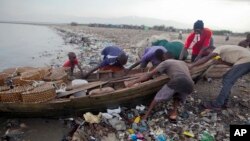Haitian authorities and aid agencies were scrambling Wednesday to prepare for Hurricane Irma, the strongest Atlantic storm on record, warning it could devastate the country still reeling from drought and last year’s Hurricane Matthew.
Barreling through the Caribbean, the “extremely dangerous” core of Irma was predicted to strike northern Haiti and the Dominican Republic as well as the Turks and Caicos and Bahamas on Thursday with winds of 185 miles per hour (295 km per hour), the U.S. National Hurricane Center said.
The eye of Irma, a Category 5 storm, passed over the northern Virgin Islands on Wednesday after crossing the half-French, half-Dutch island of St. Martin and the Dutch islands of Saba and Sint Eustasius. Category 5 is the highest hurricane ranking used by U.S. forecasters.
Nation on alert
Haitian authorities put the nation on alert, closing schools, moving people to shelters and mobilizing 18,000 civil and Red Cross volunteers backed by police and the military.
“Irma is expected to sweep across the northern part of the country, so besides the strong winds and rain that could cause damage to houses, it is likely that many areas will be affected by flooding, landslides, and loss of livestock,” said Jessica Pearl, Haiti country director for aid agency Mercy Corps.
More than half of the population depends on agriculture, “so any damage to their farms or livestock could make the difference of eating or not for the next few months,” she said.
Farming communities in Haiti, one of the world’s poorest nations, are struggling to recover from Category 4 Matthew last October.
Matthew killed about 1,000 people and left 1.4 million others in need of food aid.
Aid systems in place
Irma will also bring “major consequences” to northern Haiti, which also has suffered three years of drought, said Ronald Tran Ba Huy, Haiti country director for the U.N World Food Program (WFP). But systems to handle health, water and housing put in place for Matthew remain and can be used for Irma, he said.
“Lessons learnt and mechanisms are fresh,” he said.
The WFP said it has food supplies across Haiti, a nation of 10.8 million people, for 150,000 people for one month, and trucks carrying emergency food aid to northern Haiti would be able to reach 40,000 people immediately.
Damage likely to be magnified
Poor infrastructure and a lack of flood prevention measures such as coastal embankments and drainage systems, along with widespread deforestation, are likely to magnify damage from Irma as they did with Matthew, aid agencies say.
The international aid community has been criticized for a slow response and poor coordination to disasters in Haiti, including a 2010 earthquake.
“There is an effort on the part of the international community to address the lessons learned from Matthew and have a more efficient response this time,” Pearl said.
“That said, the government consists of new people on a steep learning curve,” she added. Haiti’s new government took power in March.









